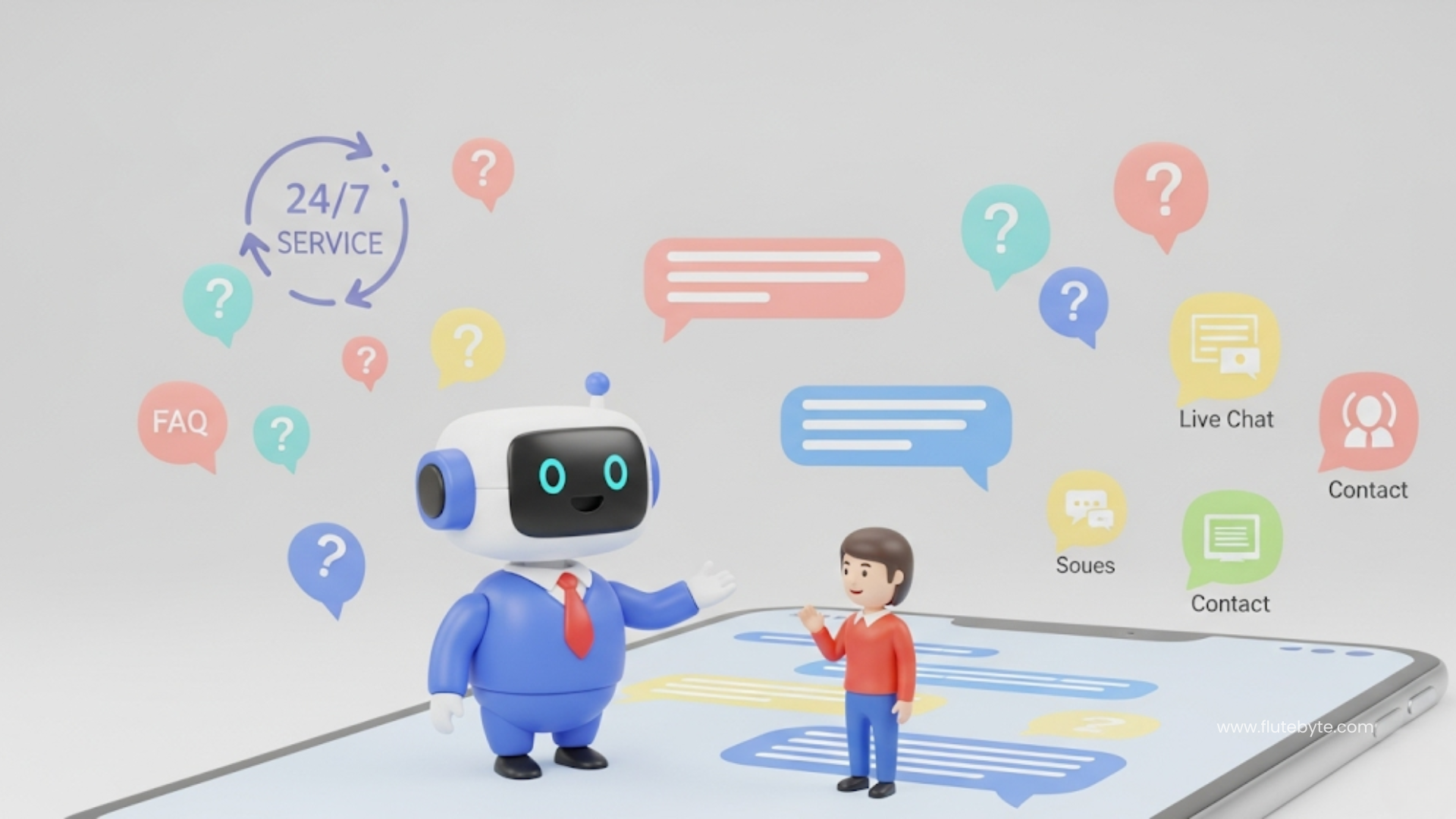Introduction
In today’s fast-paced digital marketplace, customer service expectations are higher than ever. Small businesses often find it challenging to keep up with customer inquiries around the clock using limited staff. This is where AI chatbots come in. AI chatbot customer service solutions use artificial intelligence to simulate human-like conversations, enabling even the smallest companies to provide quick, efficient support at any time of day. From answering routine questions to guiding customers through orders, chatbots for small business have evolved from novelty to necessity. In fact, about one-third of businesses now use chatbots in their customer support interactions, a number that continues to grow worldwide. Whether a customer contacts a shop via a website chat at midnight or sends a message on WhatsApp during the weekend, an intelligent bot can respond instantly. For small and medium-sized enterprises (SMEs), this technology offers a way to automate customer support and deliver consistent service without hiring large support teams. The following sections explore the key chatbot benefits for SMEs, practical use cases, platform options, and best practices for implementing AI chatbots to improve customer service. By leveraging these tools, small businesses globally — from India to the U.S. — can enhance customer satisfaction and stay competitive.
Chatbot Benefits for SMEs in Customer Service
Implementing an AI chatbot can offer numerous advantages for a small business’s customer service operations. Some of the key chatbot benefits for SMEs include:
- 24/7 Availability and Instant Response: Chatbots never sleep, meaning customers can get help at any time of day or night. An AI bot can instantly answer questions or troubleshoot issues, ensuring no customer has to wait until business hours for a reply. This round-the-clock availability is especially valuable for a global customer base or businesses in sectors (like e-commerce) where inquiries come in outside the 9-to-5 window. Quick, real-time responses also prevent customer frustration and keep the service experience smooth.
- Cost Savings and Efficiency: By automating common customer support tasks (answering FAQs, checking order status, etc.), a chatbot reduces the workload on human staff. This leads to significant cost savings — industry research shows that using chatbots can cut customer service expenses by around 30%. Small teams are able to handle a larger volume of inquiries without hiring extra agents. Meanwhile, employees can focus on complex or high-value customer issues, improving efficiency and reducing burnout from repetitive questions.
- Scalability and Consistency: A single chatbot can engage with dozens of customers simultaneously, scaling effortlessly during peak hours. Small businesses no longer need to worry about call waiting lines or overflowing email inboxes when demand spikes. Every customer receives the same prompt attention. Additionally, chatbots deliver consistent answers based on their programming, so customers get accurate, uniform information every time. This consistency helps maintain quality and avoids the variability that can happen with different human reps.
- Improved Customer Experience: Chatbots help eliminate long hold times and unanswered emails, leading to a better overall customer experience. Many customers actually prefer a quick chat interaction for simple issues. An AI chatbot can greet users in a friendly manner and guide them to solutions faster than a traditional support channel. Chatbots can also offer self-service options — such as letting users track a shipment or reset a password via chat — empowering customers to resolve issues on their own terms. The result is often more engaged, satisfied customers who feel the business is responsive to their needs.
- Valuable Insights: Every interaction with a chatbot can be recorded and analyzed. This gives small businesses direct feedback on what customers are asking and where their pain points are. By reviewing chatbot logs, an SME might discover frequently asked questions or recurring complaints that inform product improvements or new support content. In this way, deploying a chatbot not only serves customers in the moment but also generates data to help the business continuously improve its services.
- Multilingual Support: AI chatbots can be configured to converse in multiple languages, which is a huge advantage for businesses serving diverse markets. Instead of hiring multilingual support staff, a single bot can seamlessly switch between, say, English and Hindi or French and Arabic. Customers get help in their preferred language, improving comfort and clarity. For example, in India a chatbot could handle queries in regional languages (vernacular support) on WhatsApp, allowing a local small business to engage a broader audience. This capability helps small companies provide inclusive customer service across different regions.
Key Use Cases for AI Chatbots in Customer Support
Small businesses are using AI chatbots in a variety of creative ways to enhance customer support. Here are some of the most common and impactful use cases:
- Instant Answers to FAQs: One major use of chatbots is to automatically handle frequently asked questions from customers. Instead of having staff repeatedly answer queries like “What are your business hours?” or “Where is my order?”, a chatbot can provide these answers immediately. This reduces the load on phones and emails. For example, a customer on a website or Facebook page can ask the bot about a product or return policy and get an instant, accurate reply at any time.
- Lead Generation and Qualification: AI chatbots can act as the first point of contact for potential customers, capturing leads and guiding them down the sales funnel. When a visitor comes to a small business website, a chatbot can proactively greet them and ask questions about their needs. By collecting information (budget, service interest, contact details, etc.), the bot qualifies the lead automatically. For instance, a real estate agency’s chatbot might ask what type of property a visitor is looking for and their price range, then pass on high-quality leads to the human sales team. This automated lead qualification ensures that sales staff spend time on the most promising prospects.
- Appointment Booking and Scheduling: Another popular use-case is using chatbots to schedule appointments or reservations. Small businesses in hospitality, healthcare, beauty, and other services can have a bot handle the booking process from start to finish. Customers interact with the bot to pick a time slot, provide their details, and get a confirmation — all without human involvement. For example, a WhatsApp chatbot for business can let a client book a salon appointment simply by chatting, with the bot checking available times and sending a confirmation instantly. This not only saves staff time, but also makes booking more convenient for customers.
- E-Commerce and Order Support: In online retail, chatbots help enhance the shopping experience. They can guide users to find products based on queries (“I’m looking for running shoes under $50”), suggest related items, and assist with order tracking or returns. If a customer asks “Where is my package?”, the chatbot can pull up shipment data and provide a quick update. Some advanced implementations even allow customers to add items to their cart or complete a purchase through a chat interface. For a small e-commerce business, these capabilities mean providing personalized shopping assistance similar to a store associate, but through the website chat or messaging app.
- Customer Feedback and Follow-Up: Chatbots can also play a role after a service interaction. They can automatically send customers a brief satisfaction survey or follow-up message to ensure the issue was resolved. For example, after a support chat (whether with a bot or a human agent), a chatbot could pop up asking “How was your experience today?” and collect ratings or comments. This helps small businesses gather feedback at scale. Similarly, bots can gently remind customers about items left in their online cart or send post-purchase tips (like how to care for a product), thereby improving engagement and prompting return visits.
Choosing the right chatbot platform or channel is important for successful implementation. Small businesses have several options:
Website and Live Chat Platforms: Many SMEs start by adding a chatbot to their website or online store. Services like Tidio, LiveChat, and Intercom provide user-friendly chat widgets that can be embedded on a site, often with AI chatbot capabilities out-of-the-box. These platforms usually offer visual builders or templates, making it easy to set up a chatbot without coding. Freshchat (part of Freshworks) is another popular platform, especially in regions like India and Europe, combining live chat and AI bot features. Such tools allow a small business to manage web chat conversations and automate FAQs or lead capture in one place.
Messaging Apps (WhatsApp and More): Messaging channels are extremely popular for customer interactions, so businesses often deploy chatbots on those apps as well. The WhatsApp Business API enables companies to integrate a bot into WhatsApp – a crucial channel in markets across Asia, the Middle East, Africa, and beyond. A WhatsApp-based chatbot can handle inquiries from customers just as a website chat would, but via the WhatsApp interface that many people prefer. Similarly, chatbots can be created for Facebook Messenger, Telegram, or SMS, depending on where your audience is most active. Using chatbots on these mobile messaging apps helps companies meet customers on the platforms they already use daily.
Custom AI Chatbot Solutions: For advanced needs or more customization, small businesses can leverage AI frameworks to build their own chatbot solutions. Google’s Dialogflow is one example of a platform where you can design custom conversation flows and integrate them into various channels (website, app, WhatsApp, etc.). Another cutting-edge option is using the ChatGPT API (from OpenAI) or similar large language model APIs to create highly sophisticated conversational bots tailored to your business. These custom-built bots can be programmed to understand complex queries and pull data from your internal systems. However, they typically require more technical expertise or a development partner. The benefit is a chatbot uniquely suited to your processes – for instance, integrated with your order database or CRM – providing a more personalized and context-aware customer service experience.
Integration with Business Systems: Many modern chatbot platforms (both off-the-shelf and custom) allow integration with Customer Relationship Management (CRM) software and other business systems. This means the bot can retrieve account details, order statuses, and other data to personalize the conversation. In the U.S. and other tech-forward markets, it’s common to see small businesses linking their chatbot with back-end systems so the AI can greet returning customers by name, reference their last order, or update records. For example, a chatbot connected to a CRM can tell a user, “Hi John, your last order is on its way and should arrive tomorrow.” Such integration enables a seamless experience where the chatbot isn’t just answering generic questions, but providing context-rich support that feels tailored to each customer.
Best Practices for Implementing AI Chatbots
Even with great technology, the success of an AI chatbot in customer service depends on how well it’s implemented. Here are some best practices and tips for small businesses:
- Start with Clear Goals: Identify what you want to achieve with a chatbot. Is the primary purpose to answer customer support questions, reduce response times, qualify new sales leads, or something else? Defining specific use cases (like “handle order tracking questions” or “capture new inquiries from website visitors”) will help shape the chatbot’s design. Clear goals ensure that the chatbot is built to meet real business needs and customer expectations.
- Choose the Right Channels and Platform: Meet your customers where they are. Determine which communication channels your audience uses most – it could be your website, mobile app, WhatsApp, Facebook Messenger, or all of the above. Prioritize deploying the chatbot on those channels. Also select a platform or technology that fits your resources: a no-code chatbot builder is ideal if you lack technical expertise, whereas an advanced AI platform might be chosen if you have developer support. For example, a small business in a mobile-centric market like the UAE or India might focus on implementing a WhatsApp chatbot via the Business API, whereas a U.S. company might integrate a chatbot with its website and CRM system. The key is to launch the bot on the platforms where your customers are most active, and to use a solution that you can manage effectively.
- Design an Effective Conversation Flow: Keep the chatbot’s dialogue friendly, concise, and on-brand. Anticipate the main questions or tasks users will have and create clear flows for these. It’s often best to start with a simple menu or greeting that guides users (e.g., “Hello! How can I help you today? [Track an Order] [Ask a Question] [Speak to an Agent]”). Ensure the bot can handle natural variations of common questions through AI training or predefined keyword triggers. Importantly, always provide an easy way for users to reach a human if the bot gets stuck or if the user requests it. Customers appreciate knowing that an agent is just one click or command away (for instance, offering a “Talk to a human agent” option). This safety net maintains trust and prevents user frustration when an AI doesn’t have the answer.
- Test and Iterate Gradually: Before fully rolling out your chatbot, test it thoroughly. Run through numerous scenarios internally and with a small group of real users if possible. Observe how the AI handles different phrasings and where it might falter. It’s normal to discover questions it cannot answer or situations where it misunderstands the user. Use this pilot phase to refine the bot’s responses and expand its knowledge base. Once live, consider a soft launch (e.g. the bot handles only a few types of questions initially) and gather feedback. Monitor chat transcripts and analytics to see how users interact and where drop-offs occur. Continuously update the chatbot based on these insights – improvement is an ongoing process, not a one-time project. Over time, your bot will become smarter and more helpful as it learns from real interactions.
- Maintain and Enhance Over Time: Treat your chatbot as a dynamic part of your customer service team. Monitor key performance indicators like resolution rate, average response time, and user satisfaction (you can ask customers to rate their chatbot experience). If the bot is failing to answer certain questions often, update its content or add those Q&As to its database. Keep the bot’s information current – for example, if your business changes a policy or runs a new promotion, make sure the chatbot knows about it. Regular maintenance ensures the bot remains accurate and useful. Additionally, stay mindful of customer privacy: if your chatbot collects names, emails, or other personal data, be transparent about how that data is used and secure it properly. By keeping the chatbot up-to-date and customer-centric, you’ll ensure it continues to deliver value and positive service experiences.
Conclusion and Call-to-Action
AI chatbots have emerged as a powerful equalizer in customer service, allowing small businesses to offer responsive, intelligent support that rivals what much larger companies can provide. By handling inquiries instantly, consistently, and around the clock, a well-implemented chatbot can significantly improve customer satisfaction and loyalty. The examples above demonstrate that – from answering FAQs to booking appointments – chatbots can seamlessly fill a variety of customer service roles. Notably, adoption of chatbot technology is accelerating worldwide; millions of SMEs are already deploying chatbots on websites and messaging apps (for instance, over 15 million small businesses are using WhatsApp Business as part of their digital customer engagement strategy). Implementing an AI chatbot isn’t just about cutting costs; it’s about meeting modern customer expectations and positioning your business for growth in an increasingly digital marketplace.
Importantly, small businesses don’t have to navigate this tech alone. Partnering with the right experts can make deploying a chatbot much easier. Flutebyte Technologies offers professional support to help companies integrate these solutions effectively. From web development and software solutions to Shopify development, SaaS development, and comprehensive IT services, Flutebyte can assist at every step of the journey. Whether you need a custom chatbot built on the latest AI APIs or a full-fledged e-commerce website with chatbot support, their team can deliver a tailored solution. Leveraging such expertise ensures that your AI chatbot truly improves your customer service and aligns with your business goals.
By investing in AI chatbots now, small businesses can improve their customer service experience and streamline operations, all while staying competitive on the global stage. It’s an innovation in efficiency and customer satisfaction that can pay dividends in the long run. Consider reaching out to Flutebyte Technologies to explore how an AI chatbot (and other digital solutions) could elevate your business’s customer service to the next level.
FAQs
Q1: How do AI chatbots improve customer service for small businesses?
A: By deploying an AI chatbot for customer service, small businesses can respond to customers faster and at any hour. Chatbots handle routine queries automatically, so customers get instant answers without waiting for a human representative. With 24/7 availability, consistent information, and quick problem resolution, a chatbot helps enhance the overall customer experience that a small business can provide.
Q2: Can small businesses use chatbots to automate customer support?
A: Yes, chatbots are a great tool to automate customer support tasks. A small business can program a chatbot to address common questions (like pricing, operating hours, or basic troubleshooting), guide users through simple processes, and even handle requests like order tracking or appointment scheduling. This automation frees up human staff to focus on more complex inquiries, while the bot efficiently takes care of the repetitive support requests.
Q3: How can a WhatsApp chatbot for business improve customer service?
A: A WhatsApp chatbot allows a small business to serve customers through a channel they use every day. It can instantly answer customer messages on WhatsApp, provide information in local languages, and even process requests like bookings or support tickets right within the chat. Because WhatsApp is so popular in many regions, having a chatbot there means customers get quick responses and interactive service without needing to call or visit a website – greatly improving convenience and satisfaction.
Q4: What are the best AI chatbot platforms for small businesses?
A: The “best” platform depends on the business’s needs, but there are several popular options. For a quick website chatbot, user-friendly services like Tidio, LiveChat, or Freshchat let small companies set up chatbots easily. If the goal is to assist customers on messaging apps, the WhatsApp Business API is a top choice to deploy a bot on WhatsApp. Meanwhile, tech-savvy teams might use Google’s Dialogflow or OpenAI’s ChatGPT API to build a custom chatbot. The ideal platform is one that fits your technical resources and supports the channels where your customers are most active.
Q5: What are some best practices for implementing chatbots in a small business?
A: Key best practices include: start by defining the main tasks you want the chatbot to handle (so it has a clear purpose); use the channels your customers prefer (for example, integrate with WhatsApp or your website as needed); keep the bot’s responses simple and helpful, and always offer a quick option to reach a human agent if the user gets frustrated or needs extra help. It’s also important to test the chatbot thoroughly before full launch, then continually improve it by updating its information and learning from customer interactions. By ensuring the chatbot stays accurate, easy to use, and customer-friendly, a small business will get the best results from the technology.
Sources
- Exploding Topics – “Chatbot Statistics (2025)” – Statistics on chatbot adoption and impact (e.g., ~37% of businesses using chatbots, faster response times).
- U.S. Chamber of Commerce (CO—) – “Could Your Small Business Benefit from a Chatbot?” – Discussion of chatbot benefits (24/7 support, multilingual help, streamlined workflows for employees) for small businesses.
- Cequens Blog – “5 Ways WhatsApp Chatbots Boost Customer Engagement in the Middle East” – Notable stats on WhatsApp usage and chatbot benefits (e.g., 85% of businesses using WhatsApp, 30% reduction in support costs with chatbots).
- IBM – “Unlocking the Power of Chatbots: Key Benefits for Businesses and Customers” – Explanation of chatbot advantages like multi-language support to reach a worldwide audience.
- Bain & Company – “Win with Conversations” (2023) – Report highlighting conversational commerce trends (e.g., ~15 million SMBs using WhatsApp for Business to engage customers).




